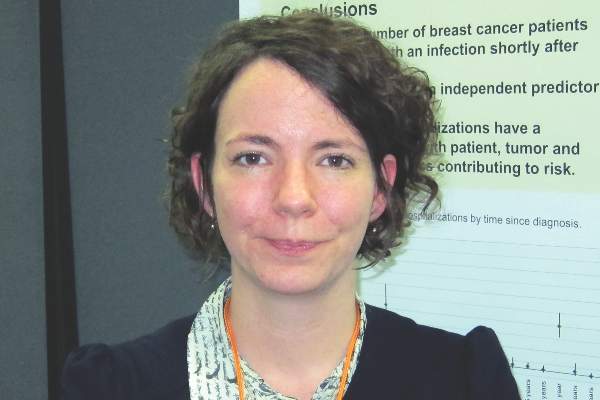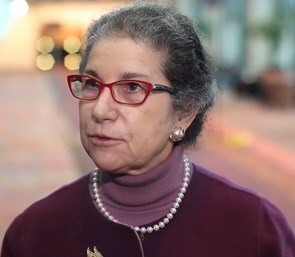User login
Cancer Therapy & Research Center (CTRC)/ American Association for Cancer Research (AACR): San Antonio Breast Cancer Symposium (SABCS)
VIDEO: Cleveland Clinic experts provide SABCS take-home messages
SAN ANTONIO –The San Antonio Breast Cancer Symposium had a lot to offer clinicians. Cleveland Clinic breast cancer experts Dr. Jame Abraham, Dr. Holly Pederson, and Dr. Alberto Montero outline take-home messages from research presented at the San Antonio Breast Cancer Symposium. The panel agreed that some findings were practice-changing – particularly results showing adjuvant denosumab not only reduces fracture risk for women but also improves breast cancer outcomes – while findings for other treatments, including immunotherapy for breast cancer, have a long way to go before arriving in the clinic.
Dr. Pederson highlighted presentations on prevention, including findings linking aspirin with lower breast density. She also said presentations confirmed for her that gene panels are here to stay in helping identify and manage women at high risk of breast cancer.
The panelists also discussed the clinical relevance of studies on neoadjuvant carboplatin and on using capecitabine for cleanup of residual disease after neoadjuvant therapy.
The three panelists had no financial disclosures related to these studies.
The video associated with this article is no longer available on this site. Please view all of our videos on the MDedge YouTube channel
SAN ANTONIO –The San Antonio Breast Cancer Symposium had a lot to offer clinicians. Cleveland Clinic breast cancer experts Dr. Jame Abraham, Dr. Holly Pederson, and Dr. Alberto Montero outline take-home messages from research presented at the San Antonio Breast Cancer Symposium. The panel agreed that some findings were practice-changing – particularly results showing adjuvant denosumab not only reduces fracture risk for women but also improves breast cancer outcomes – while findings for other treatments, including immunotherapy for breast cancer, have a long way to go before arriving in the clinic.
Dr. Pederson highlighted presentations on prevention, including findings linking aspirin with lower breast density. She also said presentations confirmed for her that gene panels are here to stay in helping identify and manage women at high risk of breast cancer.
The panelists also discussed the clinical relevance of studies on neoadjuvant carboplatin and on using capecitabine for cleanup of residual disease after neoadjuvant therapy.
The three panelists had no financial disclosures related to these studies.
The video associated with this article is no longer available on this site. Please view all of our videos on the MDedge YouTube channel
SAN ANTONIO –The San Antonio Breast Cancer Symposium had a lot to offer clinicians. Cleveland Clinic breast cancer experts Dr. Jame Abraham, Dr. Holly Pederson, and Dr. Alberto Montero outline take-home messages from research presented at the San Antonio Breast Cancer Symposium. The panel agreed that some findings were practice-changing – particularly results showing adjuvant denosumab not only reduces fracture risk for women but also improves breast cancer outcomes – while findings for other treatments, including immunotherapy for breast cancer, have a long way to go before arriving in the clinic.
Dr. Pederson highlighted presentations on prevention, including findings linking aspirin with lower breast density. She also said presentations confirmed for her that gene panels are here to stay in helping identify and manage women at high risk of breast cancer.
The panelists also discussed the clinical relevance of studies on neoadjuvant carboplatin and on using capecitabine for cleanup of residual disease after neoadjuvant therapy.
The three panelists had no financial disclosures related to these studies.
The video associated with this article is no longer available on this site. Please view all of our videos on the MDedge YouTube channel
EXPERT ANALYSIS FROM SABCS 2015
Premenopausal women with luminal A tumors may be able to skip chemo
SAN ANTONIO – Adjuvant chemotherapy does not improve outcomes in premenopausal women with luminal A breast cancer, suggests a prospective-retrospective study using samples from the 77B randomized trial of the Danish Breast Cancer Cooperative Group (DBCG).
Researchers led by Dr. Torsten O. Nielsen, professor of pathology at the University of British Columbia, Vancouver, performed immunohistochemical intrinsic subtyping on tissue microarrays from 709 participants in the trial, which began in 1977.
The women in the trial had high-risk features – positive axillary lymph nodes or tumors greater than 5 cm – and were treated with mastectomy, axillary node dissection, and radiation therapy, but no endocrine therapy. They were randomized to cyclophosphamide-based chemotherapy or no chemotherapy.
Results of the new study, reported in a session and press briefing at the San Antonio Breast Cancer Symposium, showed that patients with luminal A tumors did not see any improvement in 10-year invasive disease–free survival from chemotherapy versus no chemotherapy. In contrast, patients with other subtypes had a halving of the risk of events.
“Women with luminal A breast cancers derive no benefit from chemotherapy – even premenopausal, node positive, and no endocrine therapy,” Dr. Nielsen said. “You might expect that this would be a particularly difficult set of patients [in which to find a group that was] lacking benefit from chemotherapy. Nonetheless, we did find that group.”
It is unclear whether the findings are robust enough to change practice, he said. “The community has to decide if it is enough evidence. Technically, this is level 2 evidence. If you feel that there is another trial that’s very well matched and [has] similar results, you might consider it level 1 evidence.”
Press briefing moderator Dr. Virginia Kaklamani, professor of medicine, University of Texas, San Antonio, noted that the recently closed RxPONDER trial used OncoType DX to randomize low-risk women to chemotherapy versus no chemotherapy and should shed more light on this issue in the contemporary treatment era.
“But this data kind of confirms what we believe, that you probably don’t need chemotherapy for those patients. So this is another step, and for me, it gives me a little more confidence in my premenopausal women – because I was pretty confident in my postmenopausal women – but in my premenopausal women, to not push chemotherapy,” she said.
“This is clearly part of a body of evidence that’s building up and may be one of the themes of the conference here, that we can probably back off on the aggressiveness of our treatments and still achieve the same results,” Dr. Nielsen agreed, noting there have been similar trends in surgery and radiation therapy. “And this is where we want to be in cancer research. We cure a lot of women with breast cancer now.”
Still, the final decision rests with the patient and physician, he acknowledged. When asked about the likely reluctance of some premenopausal women with luminal A tumors to forgo chemotherapy, he replied, “It’s a woman’s choice, I think. Most oncologists would support that, although they would provide the evidence that you were probably being overtreated.”
In the session where the data were presented, attendee Dr. Angelo Di Leo, Hospital of Prato, Istituto Toscano Tumori, Prato, Italy asked, “Did you look at the prognostic role of amenorrhea in this specific subgroup of patients? I think you should do that in the context of the luminal A patients who received adjuvant chemotherapy.”
Dr. Nielsen agreed that this information is important. If that analysis has not already been done by DBCG, “it’s something we can do as an exploratory study,” he said.
Attendee Dr. Steven Vogl, an oncologist at Montefiore Medical Center in New York, noted that a positive trial with a negative subgroup finding, as in this case, presents a quandary for oncologists. Also, the study had relatively few patients with luminal A disease who did not get chemotherapy, and the cyclophosphamide likely did confer some benefit by inducing amenorrhea.
“So I will go home saying, ‘Small numbers, old study. I don’t know what it means,’ ” he said. “Convince me I should do something about it.”
“This is the best we can do because we are looking at old studies that are randomized,” Dr. Nielsen replied, noting that the trial’s no-chemotherapy arms were closed early because of lack of benefit. “We prespecified quite a stringent statistical test with the interaction test, which is hard to meet, and it did achieve that because there absolutely was no sign of benefit in those patients.”
The issue of whether adjuvant chemotherapy provides benefit in early breast cancer was settled back in the 1980s, he noted when introducing the study. “Since that time, it’s been unethical to randomize women in those settings to no chemotherapy. Most of the studies have been different types of chemotherapies as choices.”
In contrast, participants in the 77B trial were randomized to two adjuvant chemotherapy arms (cyclophosphamide alone or cyclophosphamide, methotrexate, and fluorouracil) and two nonchemotherapy arms (levamisole or no agent). Main findings showed that chemotherapy improved 10-year invasive disease–free survival (Cancer. 2010;116:2081-9).
According to results of the subtyping, which Dr. Nielsen and colleagues performed in a central lab, 26% of the tumors were of luminal A subtype, meaning they were estrogen receptor positive and HER2 negative, had a low proliferation index (13% or fewer cells staining for Ki67), and had high progesterone receptor expression (more than 20% of cells staining) (J Clin Oncol. 2013;31:203-9).
These patients did not derive significant benefit from chemotherapy. In contrast, patients with other subtypes (luminal B, HER2E, or triple negative) had a marked benefit (hazard ratio, 0.50; 95% CI, 0.38-0.66; P less than .001).
The heterogeneity in treatment impact between luminal A and non–luminal A subtypes was statistically significant (interaction test P = .048). Analyses also showed a similar trend for the endpoint of 25-year overall survival.
Discussing study caveats, Dr. Nielsen acknowledged that immunohistochemistry scoring can be subjective. “Currently, we are trying to get the original [tissue] blocks. Isolating RNA for gene profile analysis is another way to identify the subtypes,” he explained.
SAN ANTONIO – Adjuvant chemotherapy does not improve outcomes in premenopausal women with luminal A breast cancer, suggests a prospective-retrospective study using samples from the 77B randomized trial of the Danish Breast Cancer Cooperative Group (DBCG).
Researchers led by Dr. Torsten O. Nielsen, professor of pathology at the University of British Columbia, Vancouver, performed immunohistochemical intrinsic subtyping on tissue microarrays from 709 participants in the trial, which began in 1977.
The women in the trial had high-risk features – positive axillary lymph nodes or tumors greater than 5 cm – and were treated with mastectomy, axillary node dissection, and radiation therapy, but no endocrine therapy. They were randomized to cyclophosphamide-based chemotherapy or no chemotherapy.
Results of the new study, reported in a session and press briefing at the San Antonio Breast Cancer Symposium, showed that patients with luminal A tumors did not see any improvement in 10-year invasive disease–free survival from chemotherapy versus no chemotherapy. In contrast, patients with other subtypes had a halving of the risk of events.
“Women with luminal A breast cancers derive no benefit from chemotherapy – even premenopausal, node positive, and no endocrine therapy,” Dr. Nielsen said. “You might expect that this would be a particularly difficult set of patients [in which to find a group that was] lacking benefit from chemotherapy. Nonetheless, we did find that group.”
It is unclear whether the findings are robust enough to change practice, he said. “The community has to decide if it is enough evidence. Technically, this is level 2 evidence. If you feel that there is another trial that’s very well matched and [has] similar results, you might consider it level 1 evidence.”
Press briefing moderator Dr. Virginia Kaklamani, professor of medicine, University of Texas, San Antonio, noted that the recently closed RxPONDER trial used OncoType DX to randomize low-risk women to chemotherapy versus no chemotherapy and should shed more light on this issue in the contemporary treatment era.
“But this data kind of confirms what we believe, that you probably don’t need chemotherapy for those patients. So this is another step, and for me, it gives me a little more confidence in my premenopausal women – because I was pretty confident in my postmenopausal women – but in my premenopausal women, to not push chemotherapy,” she said.
“This is clearly part of a body of evidence that’s building up and may be one of the themes of the conference here, that we can probably back off on the aggressiveness of our treatments and still achieve the same results,” Dr. Nielsen agreed, noting there have been similar trends in surgery and radiation therapy. “And this is where we want to be in cancer research. We cure a lot of women with breast cancer now.”
Still, the final decision rests with the patient and physician, he acknowledged. When asked about the likely reluctance of some premenopausal women with luminal A tumors to forgo chemotherapy, he replied, “It’s a woman’s choice, I think. Most oncologists would support that, although they would provide the evidence that you were probably being overtreated.”
In the session where the data were presented, attendee Dr. Angelo Di Leo, Hospital of Prato, Istituto Toscano Tumori, Prato, Italy asked, “Did you look at the prognostic role of amenorrhea in this specific subgroup of patients? I think you should do that in the context of the luminal A patients who received adjuvant chemotherapy.”
Dr. Nielsen agreed that this information is important. If that analysis has not already been done by DBCG, “it’s something we can do as an exploratory study,” he said.
Attendee Dr. Steven Vogl, an oncologist at Montefiore Medical Center in New York, noted that a positive trial with a negative subgroup finding, as in this case, presents a quandary for oncologists. Also, the study had relatively few patients with luminal A disease who did not get chemotherapy, and the cyclophosphamide likely did confer some benefit by inducing amenorrhea.
“So I will go home saying, ‘Small numbers, old study. I don’t know what it means,’ ” he said. “Convince me I should do something about it.”
“This is the best we can do because we are looking at old studies that are randomized,” Dr. Nielsen replied, noting that the trial’s no-chemotherapy arms were closed early because of lack of benefit. “We prespecified quite a stringent statistical test with the interaction test, which is hard to meet, and it did achieve that because there absolutely was no sign of benefit in those patients.”
The issue of whether adjuvant chemotherapy provides benefit in early breast cancer was settled back in the 1980s, he noted when introducing the study. “Since that time, it’s been unethical to randomize women in those settings to no chemotherapy. Most of the studies have been different types of chemotherapies as choices.”
In contrast, participants in the 77B trial were randomized to two adjuvant chemotherapy arms (cyclophosphamide alone or cyclophosphamide, methotrexate, and fluorouracil) and two nonchemotherapy arms (levamisole or no agent). Main findings showed that chemotherapy improved 10-year invasive disease–free survival (Cancer. 2010;116:2081-9).
According to results of the subtyping, which Dr. Nielsen and colleagues performed in a central lab, 26% of the tumors were of luminal A subtype, meaning they were estrogen receptor positive and HER2 negative, had a low proliferation index (13% or fewer cells staining for Ki67), and had high progesterone receptor expression (more than 20% of cells staining) (J Clin Oncol. 2013;31:203-9).
These patients did not derive significant benefit from chemotherapy. In contrast, patients with other subtypes (luminal B, HER2E, or triple negative) had a marked benefit (hazard ratio, 0.50; 95% CI, 0.38-0.66; P less than .001).
The heterogeneity in treatment impact between luminal A and non–luminal A subtypes was statistically significant (interaction test P = .048). Analyses also showed a similar trend for the endpoint of 25-year overall survival.
Discussing study caveats, Dr. Nielsen acknowledged that immunohistochemistry scoring can be subjective. “Currently, we are trying to get the original [tissue] blocks. Isolating RNA for gene profile analysis is another way to identify the subtypes,” he explained.
SAN ANTONIO – Adjuvant chemotherapy does not improve outcomes in premenopausal women with luminal A breast cancer, suggests a prospective-retrospective study using samples from the 77B randomized trial of the Danish Breast Cancer Cooperative Group (DBCG).
Researchers led by Dr. Torsten O. Nielsen, professor of pathology at the University of British Columbia, Vancouver, performed immunohistochemical intrinsic subtyping on tissue microarrays from 709 participants in the trial, which began in 1977.
The women in the trial had high-risk features – positive axillary lymph nodes or tumors greater than 5 cm – and were treated with mastectomy, axillary node dissection, and radiation therapy, but no endocrine therapy. They were randomized to cyclophosphamide-based chemotherapy or no chemotherapy.
Results of the new study, reported in a session and press briefing at the San Antonio Breast Cancer Symposium, showed that patients with luminal A tumors did not see any improvement in 10-year invasive disease–free survival from chemotherapy versus no chemotherapy. In contrast, patients with other subtypes had a halving of the risk of events.
“Women with luminal A breast cancers derive no benefit from chemotherapy – even premenopausal, node positive, and no endocrine therapy,” Dr. Nielsen said. “You might expect that this would be a particularly difficult set of patients [in which to find a group that was] lacking benefit from chemotherapy. Nonetheless, we did find that group.”
It is unclear whether the findings are robust enough to change practice, he said. “The community has to decide if it is enough evidence. Technically, this is level 2 evidence. If you feel that there is another trial that’s very well matched and [has] similar results, you might consider it level 1 evidence.”
Press briefing moderator Dr. Virginia Kaklamani, professor of medicine, University of Texas, San Antonio, noted that the recently closed RxPONDER trial used OncoType DX to randomize low-risk women to chemotherapy versus no chemotherapy and should shed more light on this issue in the contemporary treatment era.
“But this data kind of confirms what we believe, that you probably don’t need chemotherapy for those patients. So this is another step, and for me, it gives me a little more confidence in my premenopausal women – because I was pretty confident in my postmenopausal women – but in my premenopausal women, to not push chemotherapy,” she said.
“This is clearly part of a body of evidence that’s building up and may be one of the themes of the conference here, that we can probably back off on the aggressiveness of our treatments and still achieve the same results,” Dr. Nielsen agreed, noting there have been similar trends in surgery and radiation therapy. “And this is where we want to be in cancer research. We cure a lot of women with breast cancer now.”
Still, the final decision rests with the patient and physician, he acknowledged. When asked about the likely reluctance of some premenopausal women with luminal A tumors to forgo chemotherapy, he replied, “It’s a woman’s choice, I think. Most oncologists would support that, although they would provide the evidence that you were probably being overtreated.”
In the session where the data were presented, attendee Dr. Angelo Di Leo, Hospital of Prato, Istituto Toscano Tumori, Prato, Italy asked, “Did you look at the prognostic role of amenorrhea in this specific subgroup of patients? I think you should do that in the context of the luminal A patients who received adjuvant chemotherapy.”
Dr. Nielsen agreed that this information is important. If that analysis has not already been done by DBCG, “it’s something we can do as an exploratory study,” he said.
Attendee Dr. Steven Vogl, an oncologist at Montefiore Medical Center in New York, noted that a positive trial with a negative subgroup finding, as in this case, presents a quandary for oncologists. Also, the study had relatively few patients with luminal A disease who did not get chemotherapy, and the cyclophosphamide likely did confer some benefit by inducing amenorrhea.
“So I will go home saying, ‘Small numbers, old study. I don’t know what it means,’ ” he said. “Convince me I should do something about it.”
“This is the best we can do because we are looking at old studies that are randomized,” Dr. Nielsen replied, noting that the trial’s no-chemotherapy arms were closed early because of lack of benefit. “We prespecified quite a stringent statistical test with the interaction test, which is hard to meet, and it did achieve that because there absolutely was no sign of benefit in those patients.”
The issue of whether adjuvant chemotherapy provides benefit in early breast cancer was settled back in the 1980s, he noted when introducing the study. “Since that time, it’s been unethical to randomize women in those settings to no chemotherapy. Most of the studies have been different types of chemotherapies as choices.”
In contrast, participants in the 77B trial were randomized to two adjuvant chemotherapy arms (cyclophosphamide alone or cyclophosphamide, methotrexate, and fluorouracil) and two nonchemotherapy arms (levamisole or no agent). Main findings showed that chemotherapy improved 10-year invasive disease–free survival (Cancer. 2010;116:2081-9).
According to results of the subtyping, which Dr. Nielsen and colleagues performed in a central lab, 26% of the tumors were of luminal A subtype, meaning they were estrogen receptor positive and HER2 negative, had a low proliferation index (13% or fewer cells staining for Ki67), and had high progesterone receptor expression (more than 20% of cells staining) (J Clin Oncol. 2013;31:203-9).
These patients did not derive significant benefit from chemotherapy. In contrast, patients with other subtypes (luminal B, HER2E, or triple negative) had a marked benefit (hazard ratio, 0.50; 95% CI, 0.38-0.66; P less than .001).
The heterogeneity in treatment impact between luminal A and non–luminal A subtypes was statistically significant (interaction test P = .048). Analyses also showed a similar trend for the endpoint of 25-year overall survival.
Discussing study caveats, Dr. Nielsen acknowledged that immunohistochemistry scoring can be subjective. “Currently, we are trying to get the original [tissue] blocks. Isolating RNA for gene profile analysis is another way to identify the subtypes,” he explained.
AT SABCS 2015
Key clinical point: Premenopausal women with luminal A breast cancer do not benefit from adjuvant cyclophosphamide-based chemotherapy.
Major finding: Chemotherapy improved 10-year invasive disease–free survival in women with non–luminal A tumors (hazard ratio, 0.50) but not in women with luminal A tumors.
Data source: A prospective-retrospective study assessing tumor intrinsic subtype among 709 patients with early breast cancer in an older randomized trial of chemotherapy (DBCG 77B trial).
Disclosures: Dr. Nielsen disclosed that he holds a patent for Bioclassifier, and that he consults for, receives royalties from, and is a speaker for NanoString. The Canadian Breast Cancer Foundation, the IM Daehnfeldt Foundation, and the Danish Research Council supported the study.
Statins don’t increase breast cancer risk
SAN ANTONIO – Statin therapy had no effect on the incidence of breast cancer during 823,086 person-years of prospective follow-up in the Nurses’ Health Study, Thomas P. Ahern, Ph.D., reported at the San Antonio Breast Cancer Symposium.
“Our results indicate that cholesterol-lowering statin therapy neither increases nor decreases breast cancer incidence rate in postmenopausal women. Considering the latest report indicated an increased breast cancer risk among statin users, our neutral findings should reassure physicians that statin therapy for the prevention of cardiovascular disease is safe with respect to breast cancer risk,” declared Dr. Ahern of the University of Vermont, Burlington.
The new Nurses’ Health Study analysis included 79,518 postmenopausal women followed prospectively during 2000-2012. During that period 3,055 study participants were diagnosed with invasive breast cancer.
Statin users were older, had a higher mean body mass index, were more likely to have diabetes, were far more likely to undergo regular mammographic screening, and had greater usage of nonstatin cardiopreventive medications than never-users of statins. In a multivariate regression analysis adjusted for these potential confounding factors as well as for family history of breast cancer, menopausal hormone therapy, alcohol intake, physical activity, history of benign breast disease, and reproductive history, the incidence of breast cancer did not differ between current, never-, and ever-users of statins.
Nor was the risk of breast cancer affected by longer duration of statin use, as women on the lipid-lowering medication for 8 years or more had the same null risk as those who’d been on statin therapy for a shorter time.
In drilling down to examine the separate risks of invasive ductal or lobular breast cancer, estrogen receptor–positive or –negative cancer, and in situ breast cancer, the incidence of none of these histologic types differed according to whether a patient had been on a statin. Nor did it matter whether a woman had been on a hydrophilic statin, such as rosuvastatin or pravastatin, or a lipophilic one, Dr. Ahern continued.
The Nurses’ Health Study analysis was prompted by a case-control study reported 2 years ago by investigators at Fred Hutchinson Cancer Research Center in Seattle. They found an association between 10 years or more of statin therapy and increased risk of developing ductal and lobular breast cancer (Cancer Epidemiol Biomarkers Prev. 2013 Sep;22[9]:1529-37). That report received wide publicity and caused considerable concern among women taking statins to reduce cardiovascular risk.
However, the Seattle study was much smaller than the Nurses’ Health Study. Moreover, the Seattle findings were at odds with numerous other studies as evidenced by the results of an earlier meta-analysis of seven randomized controlled trials and nine observational statin studies which showed no increased in breast cancer incidence associated with statin therapy (J Clin Oncol. 2005 Dec 1;23[34]:8606-12).
In contrast to statin therapy’s neutral effect on primary breast cancer incidence, multiple studies have shown “a very consistent and robust protective association” between statin use and breast cancer recurrence, Dr. Ahern noted. These clinical studies are supported by laboratory evidence that statins interrupt growth of many different cancers, including breast cancer, he added.
Discussant Melissa L. Bondy, Ph.D., said, “We epidemiologists always think of the Nurses’ Health Study as the end-all and be-all, the gold standard for providing insight into an exposure that would have occurred before disease onset. I believe that we get really good information from these women who have been committed to participating in this study for many years.”
“The Nurses’ Health Study population is really well characterized and is in a strong position to answer this question about statins and breast cancer risk. So I think that we can put this question to rest. We can now say that this is the end-all study and it does not look like statins increase the risk of breast cancer. It’s an important finding,” observed Dr. Bondy, professor of cancer prevention and population sciences at Baylor Medical College, Houston.
Dr. Ahern and Dr. Bondy declared having no financial conflicts of interest regarding the federally funded Nurses’ Health Study.
SAN ANTONIO – Statin therapy had no effect on the incidence of breast cancer during 823,086 person-years of prospective follow-up in the Nurses’ Health Study, Thomas P. Ahern, Ph.D., reported at the San Antonio Breast Cancer Symposium.
“Our results indicate that cholesterol-lowering statin therapy neither increases nor decreases breast cancer incidence rate in postmenopausal women. Considering the latest report indicated an increased breast cancer risk among statin users, our neutral findings should reassure physicians that statin therapy for the prevention of cardiovascular disease is safe with respect to breast cancer risk,” declared Dr. Ahern of the University of Vermont, Burlington.
The new Nurses’ Health Study analysis included 79,518 postmenopausal women followed prospectively during 2000-2012. During that period 3,055 study participants were diagnosed with invasive breast cancer.
Statin users were older, had a higher mean body mass index, were more likely to have diabetes, were far more likely to undergo regular mammographic screening, and had greater usage of nonstatin cardiopreventive medications than never-users of statins. In a multivariate regression analysis adjusted for these potential confounding factors as well as for family history of breast cancer, menopausal hormone therapy, alcohol intake, physical activity, history of benign breast disease, and reproductive history, the incidence of breast cancer did not differ between current, never-, and ever-users of statins.
Nor was the risk of breast cancer affected by longer duration of statin use, as women on the lipid-lowering medication for 8 years or more had the same null risk as those who’d been on statin therapy for a shorter time.
In drilling down to examine the separate risks of invasive ductal or lobular breast cancer, estrogen receptor–positive or –negative cancer, and in situ breast cancer, the incidence of none of these histologic types differed according to whether a patient had been on a statin. Nor did it matter whether a woman had been on a hydrophilic statin, such as rosuvastatin or pravastatin, or a lipophilic one, Dr. Ahern continued.
The Nurses’ Health Study analysis was prompted by a case-control study reported 2 years ago by investigators at Fred Hutchinson Cancer Research Center in Seattle. They found an association between 10 years or more of statin therapy and increased risk of developing ductal and lobular breast cancer (Cancer Epidemiol Biomarkers Prev. 2013 Sep;22[9]:1529-37). That report received wide publicity and caused considerable concern among women taking statins to reduce cardiovascular risk.
However, the Seattle study was much smaller than the Nurses’ Health Study. Moreover, the Seattle findings were at odds with numerous other studies as evidenced by the results of an earlier meta-analysis of seven randomized controlled trials and nine observational statin studies which showed no increased in breast cancer incidence associated with statin therapy (J Clin Oncol. 2005 Dec 1;23[34]:8606-12).
In contrast to statin therapy’s neutral effect on primary breast cancer incidence, multiple studies have shown “a very consistent and robust protective association” between statin use and breast cancer recurrence, Dr. Ahern noted. These clinical studies are supported by laboratory evidence that statins interrupt growth of many different cancers, including breast cancer, he added.
Discussant Melissa L. Bondy, Ph.D., said, “We epidemiologists always think of the Nurses’ Health Study as the end-all and be-all, the gold standard for providing insight into an exposure that would have occurred before disease onset. I believe that we get really good information from these women who have been committed to participating in this study for many years.”
“The Nurses’ Health Study population is really well characterized and is in a strong position to answer this question about statins and breast cancer risk. So I think that we can put this question to rest. We can now say that this is the end-all study and it does not look like statins increase the risk of breast cancer. It’s an important finding,” observed Dr. Bondy, professor of cancer prevention and population sciences at Baylor Medical College, Houston.
Dr. Ahern and Dr. Bondy declared having no financial conflicts of interest regarding the federally funded Nurses’ Health Study.
SAN ANTONIO – Statin therapy had no effect on the incidence of breast cancer during 823,086 person-years of prospective follow-up in the Nurses’ Health Study, Thomas P. Ahern, Ph.D., reported at the San Antonio Breast Cancer Symposium.
“Our results indicate that cholesterol-lowering statin therapy neither increases nor decreases breast cancer incidence rate in postmenopausal women. Considering the latest report indicated an increased breast cancer risk among statin users, our neutral findings should reassure physicians that statin therapy for the prevention of cardiovascular disease is safe with respect to breast cancer risk,” declared Dr. Ahern of the University of Vermont, Burlington.
The new Nurses’ Health Study analysis included 79,518 postmenopausal women followed prospectively during 2000-2012. During that period 3,055 study participants were diagnosed with invasive breast cancer.
Statin users were older, had a higher mean body mass index, were more likely to have diabetes, were far more likely to undergo regular mammographic screening, and had greater usage of nonstatin cardiopreventive medications than never-users of statins. In a multivariate regression analysis adjusted for these potential confounding factors as well as for family history of breast cancer, menopausal hormone therapy, alcohol intake, physical activity, history of benign breast disease, and reproductive history, the incidence of breast cancer did not differ between current, never-, and ever-users of statins.
Nor was the risk of breast cancer affected by longer duration of statin use, as women on the lipid-lowering medication for 8 years or more had the same null risk as those who’d been on statin therapy for a shorter time.
In drilling down to examine the separate risks of invasive ductal or lobular breast cancer, estrogen receptor–positive or –negative cancer, and in situ breast cancer, the incidence of none of these histologic types differed according to whether a patient had been on a statin. Nor did it matter whether a woman had been on a hydrophilic statin, such as rosuvastatin or pravastatin, or a lipophilic one, Dr. Ahern continued.
The Nurses’ Health Study analysis was prompted by a case-control study reported 2 years ago by investigators at Fred Hutchinson Cancer Research Center in Seattle. They found an association between 10 years or more of statin therapy and increased risk of developing ductal and lobular breast cancer (Cancer Epidemiol Biomarkers Prev. 2013 Sep;22[9]:1529-37). That report received wide publicity and caused considerable concern among women taking statins to reduce cardiovascular risk.
However, the Seattle study was much smaller than the Nurses’ Health Study. Moreover, the Seattle findings were at odds with numerous other studies as evidenced by the results of an earlier meta-analysis of seven randomized controlled trials and nine observational statin studies which showed no increased in breast cancer incidence associated with statin therapy (J Clin Oncol. 2005 Dec 1;23[34]:8606-12).
In contrast to statin therapy’s neutral effect on primary breast cancer incidence, multiple studies have shown “a very consistent and robust protective association” between statin use and breast cancer recurrence, Dr. Ahern noted. These clinical studies are supported by laboratory evidence that statins interrupt growth of many different cancers, including breast cancer, he added.
Discussant Melissa L. Bondy, Ph.D., said, “We epidemiologists always think of the Nurses’ Health Study as the end-all and be-all, the gold standard for providing insight into an exposure that would have occurred before disease onset. I believe that we get really good information from these women who have been committed to participating in this study for many years.”
“The Nurses’ Health Study population is really well characterized and is in a strong position to answer this question about statins and breast cancer risk. So I think that we can put this question to rest. We can now say that this is the end-all study and it does not look like statins increase the risk of breast cancer. It’s an important finding,” observed Dr. Bondy, professor of cancer prevention and population sciences at Baylor Medical College, Houston.
Dr. Ahern and Dr. Bondy declared having no financial conflicts of interest regarding the federally funded Nurses’ Health Study.
AT SABCS 2015
Key clinical point: A large analysis shows statin therapy doesn’t affect incidence of breast cancer.
Major finding: Statin users, including those on the lipid-lowering medication for 8 years or longer, displayed no increase in the risk of breast cancer, compared with never-users.
Data source: This analysis included 79,518 postmenopausal women followed prospectively for 823,086 person-years in the Nurses’ Health Study.
Disclosures: The National Institutes of Health sponsored the study. The presenter reported having no financial conflicts of interest.
Early infection-related hospitalization portends poor breast cancer prognosis
SAN ANTONIO – Hospitalization for an infection within the first year following diagnosis of primary nonmetastatic breast cancer is a red flag for increased risk of subsequent development of distant metastases or breast cancer–related death, Judith S. Brand, Ph.D., reported at the San Antonio Breast Cancer Symposium.
This increased risk for future adverse breast cancer outcomes was statistically significant and clinically meaningful for women hospitalized for respiratory tract or skin infections or sepsis. Those are the patients for whom particularly close monitoring for recurrence of breast cancer is warranted in the next 5 years, said Dr. Brand of the Karolinska Institute, Stockholm.
In contrast, hospitalization for a gastrointestinal or urinary tract infection didn’t achieve significance as an independent predictor of increased risk of adverse breast cancer outcomes.
Dr. Brand presented a prospective population-based study of 8,338 women diagnosed with stage I-III breast cancer in the Stockholm area during 2001-2008. During a median 4.9 years of follow-up after diagnosis, 720 women had an infection-related hospitalization, with the great majority of these events occurring during the first year.
The incidence of hospitalization for sepsis among breast cancer patients in their first year post diagnosis was 14-fold greater than in the general Swedish female population matched for age and year. Respiratory infections resulting in hospitalization were fourfold more frequent than in the general population, skin infections were eightfold more common, and GI infections were twice as common.
Infection-related hospitalizations had a strong and independent association with breast cancer mortality during follow-up, as seen in a multivariate analysis adjusted for age at diagnosis, comorbid conditions, infectious disease history, type of breast cancer therapy, and tumor characteristics including size, grade, hormone receptor status, and lymph node involvement.
Moreover, the risk of developing distant metastases was 50%-78% greater in breast cancer patients hospitalized for respiratory infection, sepsis, or skin infection, compared with breast cancer patients who didn’t have an infection-related hospitalization.
“We think the sepsis results are the most interesting findings,” Dr. Brand said in an interview. “Sepsis could be an expression of an immunosuppressed state. And sepsis itself can induce immunosuppression for a long time, which could trigger tumor growth. Animal studies have shown that in postseptic mice, tumor grows faster.”
Infection-related hospitalizations didn’t increase the future risk of locoregional recurrences.
Independent predictors of infection-related hospitalization included older age, comorbidities, markers indicative of greater tumor aggressiveness, and treatment with chemotherapy or axillary radiotherapy.
“This shows that the risk of infection-related hospitalizations is not only due to immunosuppression caused by chemotherapy, but that the characteristics of the tumor itself play a role, as do patient characteristics. This is the first epidemiologic study to show with very extensive data that all three elements contribute to the risk,” Dr. Brand said.
SAN ANTONIO – Hospitalization for an infection within the first year following diagnosis of primary nonmetastatic breast cancer is a red flag for increased risk of subsequent development of distant metastases or breast cancer–related death, Judith S. Brand, Ph.D., reported at the San Antonio Breast Cancer Symposium.
This increased risk for future adverse breast cancer outcomes was statistically significant and clinically meaningful for women hospitalized for respiratory tract or skin infections or sepsis. Those are the patients for whom particularly close monitoring for recurrence of breast cancer is warranted in the next 5 years, said Dr. Brand of the Karolinska Institute, Stockholm.
In contrast, hospitalization for a gastrointestinal or urinary tract infection didn’t achieve significance as an independent predictor of increased risk of adverse breast cancer outcomes.
Dr. Brand presented a prospective population-based study of 8,338 women diagnosed with stage I-III breast cancer in the Stockholm area during 2001-2008. During a median 4.9 years of follow-up after diagnosis, 720 women had an infection-related hospitalization, with the great majority of these events occurring during the first year.
The incidence of hospitalization for sepsis among breast cancer patients in their first year post diagnosis was 14-fold greater than in the general Swedish female population matched for age and year. Respiratory infections resulting in hospitalization were fourfold more frequent than in the general population, skin infections were eightfold more common, and GI infections were twice as common.
Infection-related hospitalizations had a strong and independent association with breast cancer mortality during follow-up, as seen in a multivariate analysis adjusted for age at diagnosis, comorbid conditions, infectious disease history, type of breast cancer therapy, and tumor characteristics including size, grade, hormone receptor status, and lymph node involvement.
Moreover, the risk of developing distant metastases was 50%-78% greater in breast cancer patients hospitalized for respiratory infection, sepsis, or skin infection, compared with breast cancer patients who didn’t have an infection-related hospitalization.
“We think the sepsis results are the most interesting findings,” Dr. Brand said in an interview. “Sepsis could be an expression of an immunosuppressed state. And sepsis itself can induce immunosuppression for a long time, which could trigger tumor growth. Animal studies have shown that in postseptic mice, tumor grows faster.”
Infection-related hospitalizations didn’t increase the future risk of locoregional recurrences.
Independent predictors of infection-related hospitalization included older age, comorbidities, markers indicative of greater tumor aggressiveness, and treatment with chemotherapy or axillary radiotherapy.
“This shows that the risk of infection-related hospitalizations is not only due to immunosuppression caused by chemotherapy, but that the characteristics of the tumor itself play a role, as do patient characteristics. This is the first epidemiologic study to show with very extensive data that all three elements contribute to the risk,” Dr. Brand said.
SAN ANTONIO – Hospitalization for an infection within the first year following diagnosis of primary nonmetastatic breast cancer is a red flag for increased risk of subsequent development of distant metastases or breast cancer–related death, Judith S. Brand, Ph.D., reported at the San Antonio Breast Cancer Symposium.
This increased risk for future adverse breast cancer outcomes was statistically significant and clinically meaningful for women hospitalized for respiratory tract or skin infections or sepsis. Those are the patients for whom particularly close monitoring for recurrence of breast cancer is warranted in the next 5 years, said Dr. Brand of the Karolinska Institute, Stockholm.
In contrast, hospitalization for a gastrointestinal or urinary tract infection didn’t achieve significance as an independent predictor of increased risk of adverse breast cancer outcomes.
Dr. Brand presented a prospective population-based study of 8,338 women diagnosed with stage I-III breast cancer in the Stockholm area during 2001-2008. During a median 4.9 years of follow-up after diagnosis, 720 women had an infection-related hospitalization, with the great majority of these events occurring during the first year.
The incidence of hospitalization for sepsis among breast cancer patients in their first year post diagnosis was 14-fold greater than in the general Swedish female population matched for age and year. Respiratory infections resulting in hospitalization were fourfold more frequent than in the general population, skin infections were eightfold more common, and GI infections were twice as common.
Infection-related hospitalizations had a strong and independent association with breast cancer mortality during follow-up, as seen in a multivariate analysis adjusted for age at diagnosis, comorbid conditions, infectious disease history, type of breast cancer therapy, and tumor characteristics including size, grade, hormone receptor status, and lymph node involvement.
Moreover, the risk of developing distant metastases was 50%-78% greater in breast cancer patients hospitalized for respiratory infection, sepsis, or skin infection, compared with breast cancer patients who didn’t have an infection-related hospitalization.
“We think the sepsis results are the most interesting findings,” Dr. Brand said in an interview. “Sepsis could be an expression of an immunosuppressed state. And sepsis itself can induce immunosuppression for a long time, which could trigger tumor growth. Animal studies have shown that in postseptic mice, tumor grows faster.”
Infection-related hospitalizations didn’t increase the future risk of locoregional recurrences.
Independent predictors of infection-related hospitalization included older age, comorbidities, markers indicative of greater tumor aggressiveness, and treatment with chemotherapy or axillary radiotherapy.
“This shows that the risk of infection-related hospitalizations is not only due to immunosuppression caused by chemotherapy, but that the characteristics of the tumor itself play a role, as do patient characteristics. This is the first epidemiologic study to show with very extensive data that all three elements contribute to the risk,” Dr. Brand said.
AT SABCS 2015
Key clinical point: Particularly close monitoring for adverse breast cancer outcomes is warranted for women with an infection-related hospitalization during the first year after breast cancer diagnosis.
Major finding: Women hospitalized for sepsis or a respiratory or skin infection during the first year after being diagnosed with stage I-III breast cancer were up to 4.8 times more likely to subsequently die of breast cancer than those without an infection-related hospitalization.
Data source: This was a prospective observational study of 8,338 Stockholm-area breast cancer patients followed for a median of 4.9 years post diagnosis.
Disclosures: The study presenter reported having no financial conflicts regarding this university-funded study.
VIDEO: TH3RESA results further solidify role of T-DM1
SAN ANTONIO – Compared with a treatment of the physician’s choice, the antibody-drug conjugate trastuzumab emtansine (T-DM1) prolongs median overall survival by almost 7 months among women with heavily pretreated HER2-positive metastatic breast cancer, according to new data from the TH3RESA trial.
In an interview at the San Antonio Breast Cancer Symposium, Dr. Hans Wildiers, professor at Katholieke Universiteit Leuven, Belgium, discusses the findings and how they further solidify the role of T-DM1 in the treatment of advanced HER2-positive disease.
The video associated with this article is no longer available on this site. Please view all of our videos on the MDedge YouTube channel
SAN ANTONIO – Compared with a treatment of the physician’s choice, the antibody-drug conjugate trastuzumab emtansine (T-DM1) prolongs median overall survival by almost 7 months among women with heavily pretreated HER2-positive metastatic breast cancer, according to new data from the TH3RESA trial.
In an interview at the San Antonio Breast Cancer Symposium, Dr. Hans Wildiers, professor at Katholieke Universiteit Leuven, Belgium, discusses the findings and how they further solidify the role of T-DM1 in the treatment of advanced HER2-positive disease.
The video associated with this article is no longer available on this site. Please view all of our videos on the MDedge YouTube channel
SAN ANTONIO – Compared with a treatment of the physician’s choice, the antibody-drug conjugate trastuzumab emtansine (T-DM1) prolongs median overall survival by almost 7 months among women with heavily pretreated HER2-positive metastatic breast cancer, according to new data from the TH3RESA trial.
In an interview at the San Antonio Breast Cancer Symposium, Dr. Hans Wildiers, professor at Katholieke Universiteit Leuven, Belgium, discusses the findings and how they further solidify the role of T-DM1 in the treatment of advanced HER2-positive disease.
The video associated with this article is no longer available on this site. Please view all of our videos on the MDedge YouTube channel
AT SABCS 2015
VIDEO: Patient-reported outcomes differ by age with anastrozole versus tamoxifen for DCIS
SAN ANTONIO – A highlight of this year’s San Antonio Breast Cancer Symposium was presentation of two large phase III trials comparing anastrozole to tamoxifen for prevention of recurrent disease in women with ductal carcinoma in situ.
In an interview, Dr. Patricia A. Ganz of the University of California, Los Angeles, breaks down the efficacy and quality of life differences between the two secondary prevention agents studied in NSABP B-35 and IBIS-II-DCIS.
The video associated with this article is no longer available on this site. Please view all of our videos on the MDedge YouTube channel
SAN ANTONIO – A highlight of this year’s San Antonio Breast Cancer Symposium was presentation of two large phase III trials comparing anastrozole to tamoxifen for prevention of recurrent disease in women with ductal carcinoma in situ.
In an interview, Dr. Patricia A. Ganz of the University of California, Los Angeles, breaks down the efficacy and quality of life differences between the two secondary prevention agents studied in NSABP B-35 and IBIS-II-DCIS.
The video associated with this article is no longer available on this site. Please view all of our videos on the MDedge YouTube channel
SAN ANTONIO – A highlight of this year’s San Antonio Breast Cancer Symposium was presentation of two large phase III trials comparing anastrozole to tamoxifen for prevention of recurrent disease in women with ductal carcinoma in situ.
In an interview, Dr. Patricia A. Ganz of the University of California, Los Angeles, breaks down the efficacy and quality of life differences between the two secondary prevention agents studied in NSABP B-35 and IBIS-II-DCIS.
The video associated with this article is no longer available on this site. Please view all of our videos on the MDedge YouTube channel
AT SABCS 2015
VIDEO: Is anastrozole or tamoxifen best for secondary prevention of DCIS?
SAN ANTONIO – Two large phase III randomized trials comparing anastrozole and tamoxifen for prevention of disease recurrence in postmenopausal women with ductal carcinoma in situ were presented at the San Antonio Breast Cancer Symposium.
In an interview, Dr. Anthony Howell, professor of medical oncology at the University of Manchester, England, provides the key take-home lessons from the NSABP B-35 and IBIS-II DCIS trials.
The video associated with this article is no longer available on this site. Please view all of our videos on the MDedge YouTube channel
SAN ANTONIO – Two large phase III randomized trials comparing anastrozole and tamoxifen for prevention of disease recurrence in postmenopausal women with ductal carcinoma in situ were presented at the San Antonio Breast Cancer Symposium.
In an interview, Dr. Anthony Howell, professor of medical oncology at the University of Manchester, England, provides the key take-home lessons from the NSABP B-35 and IBIS-II DCIS trials.
The video associated with this article is no longer available on this site. Please view all of our videos on the MDedge YouTube channel
SAN ANTONIO – Two large phase III randomized trials comparing anastrozole and tamoxifen for prevention of disease recurrence in postmenopausal women with ductal carcinoma in situ were presented at the San Antonio Breast Cancer Symposium.
In an interview, Dr. Anthony Howell, professor of medical oncology at the University of Manchester, England, provides the key take-home lessons from the NSABP B-35 and IBIS-II DCIS trials.
The video associated with this article is no longer available on this site. Please view all of our videos on the MDedge YouTube channel
AT SABCS 2015
VIDEO: Beta-blocker prevented trastuzumab-related drop in LVEF
SAN ANTONIO – Prophylactic beta-blockade with bisoprolol during adjuvant trastuzumab therapy for HER2-positive breast cancer prevented trastuzumab-induced decline in left ventricular ejection fraction in a randomized trial.
In an interview at the San Antonio Breast Cancer Symposium, Dr. Edie Pituskin of the University of Alberta, Edmonton, explained why the double-blind, placebo-controlled MANTICORE trial may change clinical practice.
The video associated with this article is no longer available on this site. Please view all of our videos on the MDedge YouTube channel
SAN ANTONIO – Prophylactic beta-blockade with bisoprolol during adjuvant trastuzumab therapy for HER2-positive breast cancer prevented trastuzumab-induced decline in left ventricular ejection fraction in a randomized trial.
In an interview at the San Antonio Breast Cancer Symposium, Dr. Edie Pituskin of the University of Alberta, Edmonton, explained why the double-blind, placebo-controlled MANTICORE trial may change clinical practice.
The video associated with this article is no longer available on this site. Please view all of our videos on the MDedge YouTube channel
SAN ANTONIO – Prophylactic beta-blockade with bisoprolol during adjuvant trastuzumab therapy for HER2-positive breast cancer prevented trastuzumab-induced decline in left ventricular ejection fraction in a randomized trial.
In an interview at the San Antonio Breast Cancer Symposium, Dr. Edie Pituskin of the University of Alberta, Edmonton, explained why the double-blind, placebo-controlled MANTICORE trial may change clinical practice.
The video associated with this article is no longer available on this site. Please view all of our videos on the MDedge YouTube channel
AT SABCS 2015
VIDEO: Estrogen receptor gene mutations linked to poorer survival
SAN ANTONIO – Mutations of the estrogen receptor 1 (ESR1) gene are more common than previously thought in women with advanced estrogen receptor–positive breast cancer and are associated with poorer survival. In an interview at the San Antonio Breast Cancer Symposium, Dr. Sarat Chandarlapaty of Memorial Sloan Kettering Cancer Center, New York, discusses a mutational analysis of cell-free DNA in blood samples from the BOLERO-2 trial and how the findings may help refine therapeutic strategies.
The video associated with this article is no longer available on this site. Please view all of our videos on the MDedge YouTube channel
SAN ANTONIO – Mutations of the estrogen receptor 1 (ESR1) gene are more common than previously thought in women with advanced estrogen receptor–positive breast cancer and are associated with poorer survival. In an interview at the San Antonio Breast Cancer Symposium, Dr. Sarat Chandarlapaty of Memorial Sloan Kettering Cancer Center, New York, discusses a mutational analysis of cell-free DNA in blood samples from the BOLERO-2 trial and how the findings may help refine therapeutic strategies.
The video associated with this article is no longer available on this site. Please view all of our videos on the MDedge YouTube channel
SAN ANTONIO – Mutations of the estrogen receptor 1 (ESR1) gene are more common than previously thought in women with advanced estrogen receptor–positive breast cancer and are associated with poorer survival. In an interview at the San Antonio Breast Cancer Symposium, Dr. Sarat Chandarlapaty of Memorial Sloan Kettering Cancer Center, New York, discusses a mutational analysis of cell-free DNA in blood samples from the BOLERO-2 trial and how the findings may help refine therapeutic strategies.
The video associated with this article is no longer available on this site. Please view all of our videos on the MDedge YouTube channel
AT SABCS 2015
VIDEO: Time to skip chemo for luminal A tumors?
SAN ANTONIO – Premenopausal women with luminal A tumors did not derive benefit from adjuvant cyclophosphamide-based chemotherapy.
In an interview, Dr. Torsten Nielsen, professor of pathology at the University of British Columbia in Vancouver, discusses the prospective-retrospective study and whether its findings will prompt patients with these tumors and their physicians to skip chemotherapy.
The video associated with this article is no longer available on this site. Please view all of our videos on the MDedge YouTube channel
SAN ANTONIO – Premenopausal women with luminal A tumors did not derive benefit from adjuvant cyclophosphamide-based chemotherapy.
In an interview, Dr. Torsten Nielsen, professor of pathology at the University of British Columbia in Vancouver, discusses the prospective-retrospective study and whether its findings will prompt patients with these tumors and their physicians to skip chemotherapy.
The video associated with this article is no longer available on this site. Please view all of our videos on the MDedge YouTube channel
SAN ANTONIO – Premenopausal women with luminal A tumors did not derive benefit from adjuvant cyclophosphamide-based chemotherapy.
In an interview, Dr. Torsten Nielsen, professor of pathology at the University of British Columbia in Vancouver, discusses the prospective-retrospective study and whether its findings will prompt patients with these tumors and their physicians to skip chemotherapy.
The video associated with this article is no longer available on this site. Please view all of our videos on the MDedge YouTube channel
AT SABCS 2015












